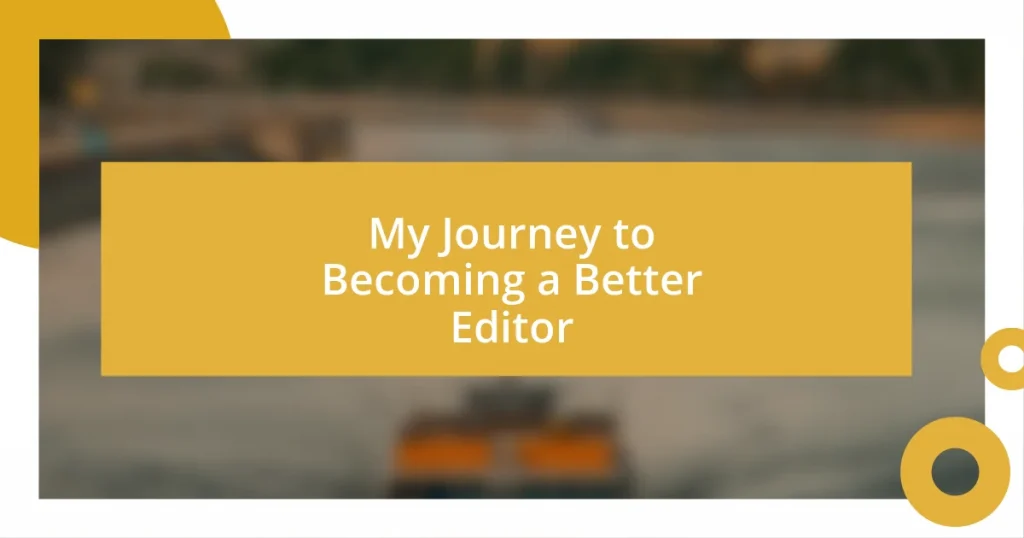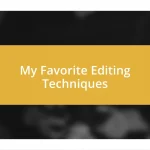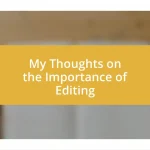Key takeaways:
- Understanding editing principles such as clarity and consistency enhances storytelling and overall impact.
- A structured editing process, including tools like checklists and collaboration platforms, streamlines work and fosters creativity.
- Seeking feedback and reflecting on edits are crucial for personal growth, encouraging collaboration and deeper connections with writers.

Understanding Editing Principles
Understanding editing principles is pivotal in shaping a cohesive narrative. I remember my early days of editing when I’d come across a beautifully written sentence that didn’t quite fit. It felt like tearing apart a piece of art, but then I realized that every element must serve the story, and that’s when I began to grasp the importance of relevance in editing.
One principle I hold dear is clarity. Have you ever struggled to follow a complex argument? I sure have! I used to think that using fancy words made my editing stronger, but I’ve learned that simplicity can often convey more power. Stripping down the convoluted phrases reveals the heart of the message, making it resonate more deeply with readers.
Consistency also plays a vital role. It’s like setting a rhythm in a song; everything flows better when there’s a unified style or tone. I recall spending hours aligning punctuation and formatting in a piece, and while it felt tedious at the time, seeing the final polished work filled me with pride. It’s a reminder that little details can make a big difference in the overall impact of writing.
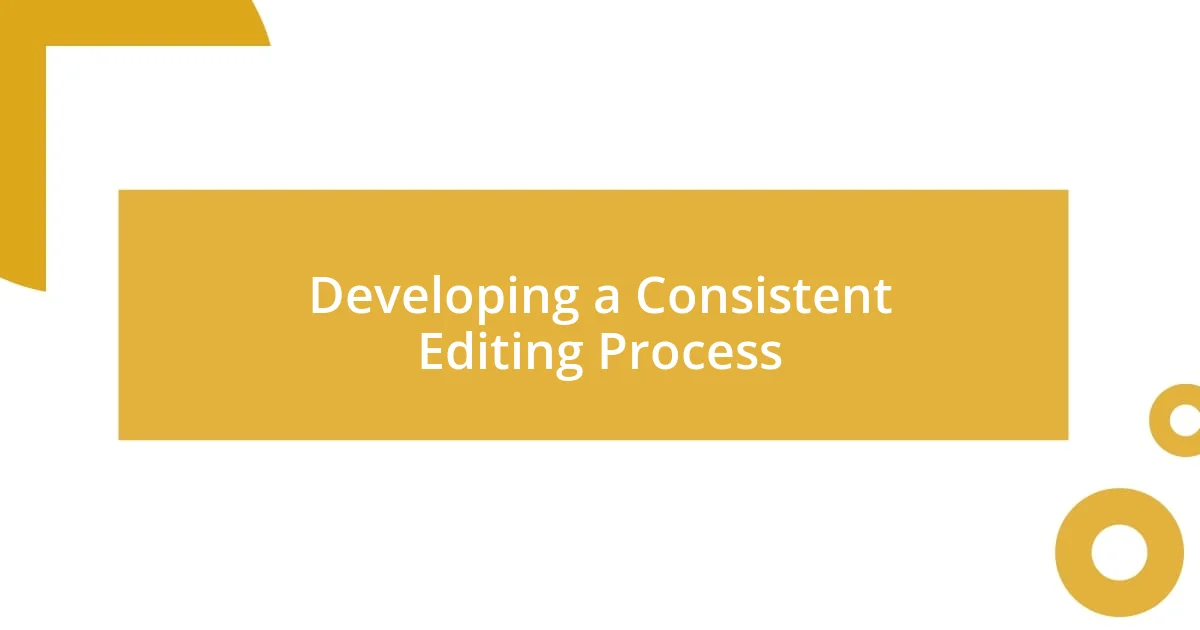
Developing a Consistent Editing Process
Developing a consistent editing process has transformed the way I approach every piece of writing. I vividly remember early on when my editing sessions felt chaotic, with no clear method in sight. It took me time, but I now believe that a structured approach not only saves time but also enhances the quality of my edits. Having a checklist or a series of steps helps me maintain focus and ensures I don’t overlook crucial details.
Here are key components I incorporate into my editing process:
- Initial Read-through: I always start with a thorough read to grasp the overall flow and tone.
- Creating a Checklist: I list essential elements like grammar, punctuation, and clarity to guide my edits.
- Take Breaks: Stepping away for a bit allows me to return with fresh eyes, catching mistakes I might have missed earlier.
- Seek Feedback: I often share my edits with others; their perspectives can reveal blind spots in my work.
- Final Review: I dedicate time to a last sweep, ensuring all changes align with the narrative’s intent.
By integrating these steps, I’ve noticed that my editing not only becomes more consistent but also more enjoyable. Instead of dreading feedback or catching mistakes, I find satisfaction in the process, knowing I’m moving closer to a polished final product.
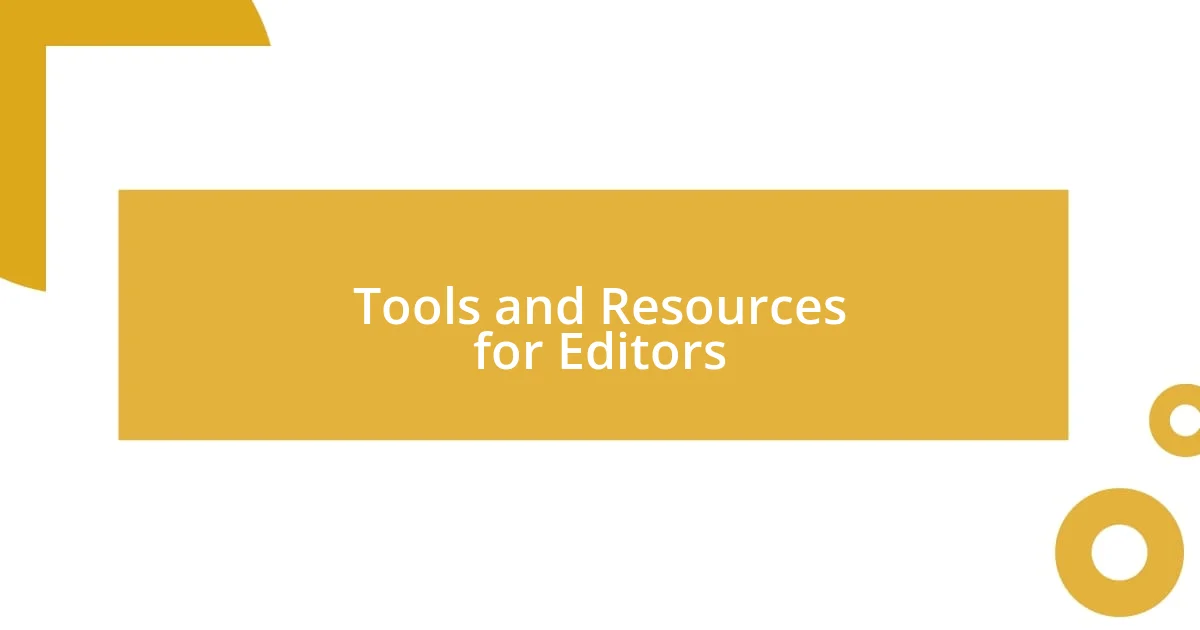
Tools and Resources for Editors
Exploring the right tools can elevate your editing journey significantly. I still recall the first time I experimented with editing software; I felt a wave of relief as I realized how much it streamlined my process. For me, tools like Grammarly and ProWritingAid have been invaluable in catching those pesky grammatical errors that sometimes slip through during manual edits. They don’t just correct mistakes; they offer suggestions that have helped me to improve my writing skills, which ultimately benefits my editing capabilities.
There’s also something incredibly satisfying about utilizing resources like style guides and thesauruses. The Chicago Manual of Style has been a trusty companion, guiding me through some of the trickiest formatting dilemmas. I often find myself flipping through it when working on diverse projects, feel a sense of certainty wash over me every time I confirm a tricky citation format. These resources give an added layer of professionalism to my editing work that, in my experience, sets it apart.
Collaboration tools have transformed how I work with writers. Platforms like Google Docs allow for real-time edits and comments, creating a dynamic interaction. I remember a collaborative project where we utilized its features, and it felt more like a conversation than a one-way editing process. Engaging directly with writers in this interactive manner not only fosters creativity but also builds trust and enhances the final product.
| Tool/Resource | Benefits |
|---|---|
| Grammarly | Catch grammatical errors and improve writing style |
| ProWritingAid | Offers in-depth reports and stylistic suggestions |
| Chicago Manual of Style | Guidance on formatting and citation rules |
| Google Docs | Real-time collaboration and commenting with writers |

Seeking Feedback and Collaboration
Seeking feedback has been a game changer in my journey as an editor. I still remember sharing my first big edit with my mentor, nervously waiting for her thoughts. When she pointed out areas for improvement, I felt a mix of anxiety and exhilaration—I was learning! Now, I actively seek out diverse opinions. I’ve learned that fresh perspectives can uncover blind spots, turning my edits into collaborative masterpieces rather than solitary efforts.
Collaboration is not just about receiving feedback, but also about building relationships. For instance, during a project with a new writer, we exchanged ideas back and forth, which sparked creativity I never expected. I realized the joy of brainstorming together, and how it transformed a tedious editing process into an engaging dialogue. Hasn’t everyone felt that spark when collaborating? When you involve others, editing becomes less about just correcting and more about creating together.
Each time I engage with others—whether it’s asking a colleague for their thoughts or working closely with a writer—I find myself more invested in the project. I often reflect on how much I’ve grown simply by being open to feedback. It feels rewarding to see how these conversations and collaborations lead to richer, more nuanced outcomes that resonate deeply with readers. Isn’t it incredible how collaboration not only elevates our work but also deepens our connections with others in this craft?
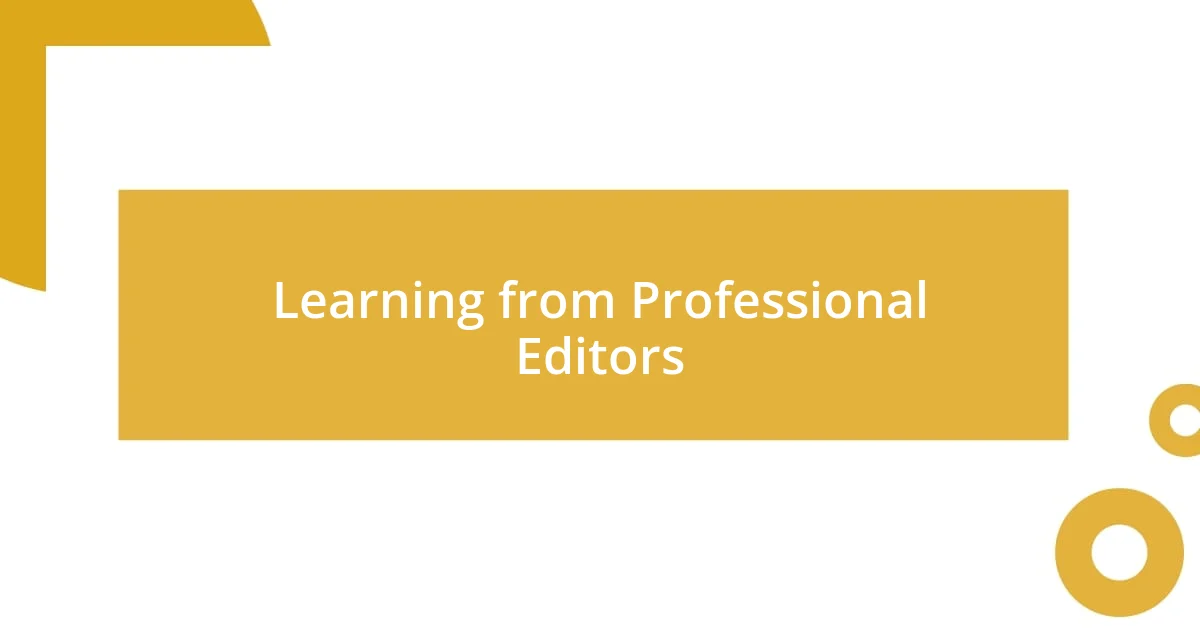
Learning from Professional Editors
Learning from professional editors has reshaped my perspective on the editing process. I remember attending a workshop led by a seasoned editor who emphasized the importance of understanding the author’s voice. That day, I realized that editing isn’t just about correcting errors; it’s about enhancing the writer’s message while preserving their unique tone. Doesn’t it feel rewarding when you help an author express themselves more clearly?
I’ve also sought mentorship from experienced editors, who have shared invaluable insights over coffee chats that feel more like friendly conversations than formal lessons. One editor shared a powerful tip: to read the text out loud. This simple practice not only catches awkward phrasing but also brings a rhythm to the writing that’s often missed in silent reading. Have you ever noticed how hearing words can completely change your understanding of them?
Additionally, I’ve embraced the habit of reviewing edits from peers. An editor friend of mine once suggested swapping work for feedback. Initially hesitant, I found the experience enlightening. Each set of eyes brings a different angle to the table, revealing flaws I might have overlooked. I learned that stepping back and inviting others to critique my work wasn’t a sign of weakness but rather a path to improvement. Isn’t it amazing how collective knowledge can lead to personal growth?

Reviewing and Reflecting on Edits
Reflecting on my edits has been an enlightening journey. I remember sitting down to review a piece I had heavily marked up, feeling a sense of pride mingled with hesitation. It was like staring at a canvas filled with colors and strokes, each mark representing my thoughts. I realized that every edit tells a story—it highlights not just what needs improvement but the evolution of my editing style. Do you ever sit back and admire your own progression?
After each round of edits, I take a moment to reflect on the choices I made. I discovered that this reflection is crucial for my growth. One time, after revisiting an old project, I cringed at certain decisions I once thought were brilliant. Noticing these shifts in my judgment fosters a sense of humility. I began to understand that learning is an ongoing process, one enriched by acknowledging past missteps. Have you felt that sense of discovery when looking back on your work?
I find it immensely beneficial to jot down my reflections after major edits. This practice gives me a chance to see patterns in my editing process over time. For instance, I noted how I was once overly focused on grammar at the expense of narrative flow. Recognizing this allowed me to adjust my approach, leading to smoother transitions. It’s funny how a simple note can illuminate areas for improvement, isn’t it? Reflecting on my edits transforms the experience into an active dialogue with myself, propelling my journey to become a better editor.










